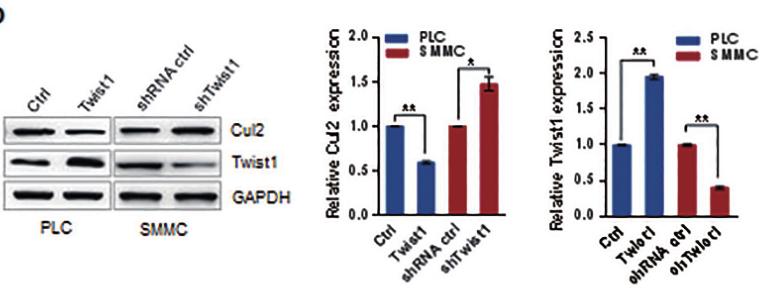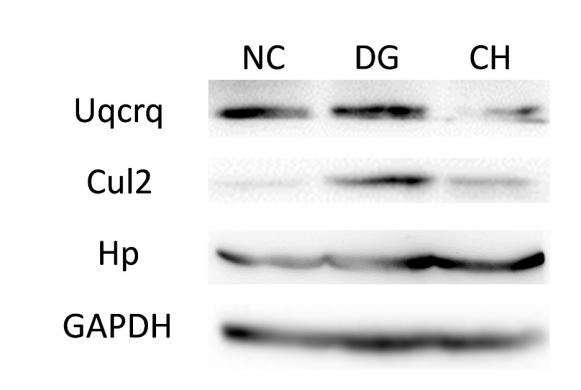Cullin 2 Antibody - #AF0141
| Product: | Cullin 2 Antibody |
| Catalog: | AF0141 |
| Description: | Rabbit polyclonal antibody to Cullin 2 |
| Application: | WB IHC IF/ICC |
| Cited expt.: | WB |
| Reactivity: | Human, Mouse, Rat |
| Prediction: | Pig, Zebrafish, Bovine, Horse, Sheep, Rabbit, Dog, Chicken, Xenopus |
| Mol.Wt.: | 82kDa,84kDa; 87kD(Calculated). |
| Uniprot: | Q13617 |
| RRID: | AB_2833323 |
Related Downloads
Protocols
Product Info
*The optimal dilutions should be determined by the end user. For optimal experimental results, antibody reuse is not recommended.
*Tips:
WB: For western blot detection of denatured protein samples. IHC: For immunohistochemical detection of paraffin sections (IHC-p) or frozen sections (IHC-f) of tissue samples. IF/ICC: For immunofluorescence detection of cell samples. ELISA(peptide): For ELISA detection of antigenic peptide.
Cite Format: Affinity Biosciences Cat# AF0141, RRID:AB_2833323.
Fold/Unfold
Cul2; CUL 2; CUL-2; CUL2; CUL2_HUMAN; cullin 2; cullin homolog 2; Cullin-2; MGC131970;
Immunogens
A synthesized peptide derived from human Cullin 2, corresponding to a region within C-terminal amino acids.
- Q13617 CUL2_HUMAN:
- Protein BLAST With
- NCBI/
- ExPASy/
- Uniprot
MSLKPRVVDFDETWNKLLTTIKAVVMLEYVERATWNDRFSDIYALCVAYPEPLGERLYTETKIFLENHVRHLHKRVLESEEQVLVMYHRYWEEYSKGADYMDCLYRYLNTQFIKKNKLTEADLQYGYGGVDMNEPLMEIGELALDMWRKLMVEPLQAILIRMLLREIKNDRGGEDPNQKVIHGVINSFVHVEQYKKKFPLKFYQEIFESPFLTETGEYYKQEASNLLQESNCSQYMEKVLGRLKDEEIRCRKYLHPSSYTKVIHECQQRMVADHLQFLHAECHNIIRQEKKNDMANMYVLLRAVSTGLPHMIQELQNHIHDEGLRATSNLTQENMPTLFVESVLEVHGKFVQLINTVLNGDQHFMSALDKALTSVVNYREPKSVCKAPELLAKYCDNLLKKSAKGMTENEVEDRLTSFITVFKYIDDKDVFQKFYARMLAKRLIHGLSMSMDSEEAMINKLKQACGYEFTSKLHRMYTDMSVSADLNNKFNNFIKNQDTVIDLGISFQIYVLQAGAWPLTQAPSSTFAIPQELEKSVQMFELFYSQHFSGRKLTWLHYLCTGEVKMNYLGKPYVAMVTTYQMAVLLAFNNSETVSYKELQDSTQMNEKELTKTIKSLLDVKMINHDSEKEDIDAESSFSLNMNFSSKRTKFKITTSMQKDTPQEMEQTRSAVDEDRKMYLQAAIVRIMKARKVLRHNALIQEVISQSRARFNPSISMIKKCIEVLIDKQYIERSQASADEYSYVA
Predictions
Score>80(red) has high confidence and is suggested to be used for WB detection. *The prediction model is mainly based on the alignment of immunogen sequences, the results are for reference only, not as the basis of quality assurance.
High(score>80) Medium(80>score>50) Low(score<50) No confidence
Research Backgrounds
Core component of multiple cullin-RING-based ECS (ElonginB/C-CUL2/5-SOCS-box protein) E3 ubiquitin-protein ligase complexes, which mediate the ubiquitination of target proteins. ECS complexes and ARIH1 collaborate in tandem to mediate ubiquitination of target proteins. May serve as a rigid scaffold in the complex and may contribute to catalysis through positioning of the substrate and the ubiquitin-conjugating enzyme. The E3 ubiquitin-protein ligase activity of the complex is dependent on the neddylation of the cullin subunit and is inhibited by the association of the deneddylated cullin subunit with TIP120A/CAND1. The functional specificity of the ECS complex depends on the substrate recognition component. ECS(VHL) mediates the ubiquitination of hypoxia-inducible factor (HIF).
Neddylated; which enhances the ubiquitination activity of ECS (Elongin BC-CUL2/5-SOCS-box protein) E3 ubiquitin-protein ligase complexes. CBC(VHL) complex formation seems to promote neddylation. Deneddylated via its interaction with the COP9 signalosome (CSN) complex (By similarity).
Belongs to the cullin family.
Research Fields
· Environmental Information Processing > Signal transduction > HIF-1 signaling pathway. (View pathway)
· Genetic Information Processing > Folding, sorting and degradation > Ubiquitin mediated proteolysis. (View pathway)
· Human Diseases > Cancers: Overview > Pathways in cancer. (View pathway)
· Human Diseases > Cancers: Specific types > Renal cell carcinoma. (View pathway)
References
Application: WB Species: human Sample: HCC cells
Application: WB Species: mice Sample: Liver tissues
Restrictive clause
Affinity Biosciences tests all products strictly. Citations are provided as a resource for additional applications that have not been validated by Affinity Biosciences. Please choose the appropriate format for each application and consult Materials and Methods sections for additional details about the use of any product in these publications.
For Research Use Only.
Not for use in diagnostic or therapeutic procedures. Not for resale. Not for distribution without written consent. Affinity Biosciences will not be held responsible for patent infringement or other violations that may occur with the use of our products. Affinity Biosciences, Affinity Biosciences Logo and all other trademarks are the property of Affinity Biosciences LTD.






